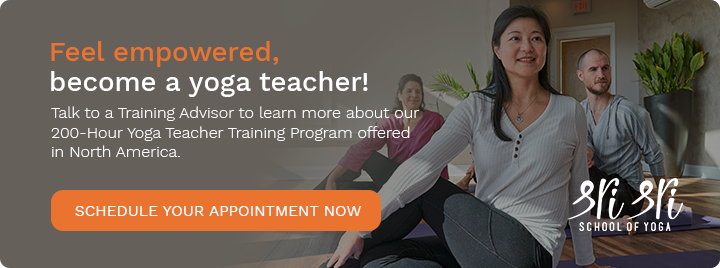Practicing yoga is much more than doing some postures. Learning to practice the full “on and off the mat routine” including observing the five Yamas and Niyamas—yoga’s guide on social and personal ethics— in your daily life can transform you and your yoga practice. Our thoughts, actions, decisions, interactions with others, our daily routines, our surroundings, everything can reflect the extent of our yoga practice. Only by such inclusive and integrated yoga practice can the ultimate goal of this ancient system be realized: bringing our bodies, minds and spirits into harmony to make us free from the bondage and miseries of life.
Sage Patanjali’s precious gift of the Yoga Sutras
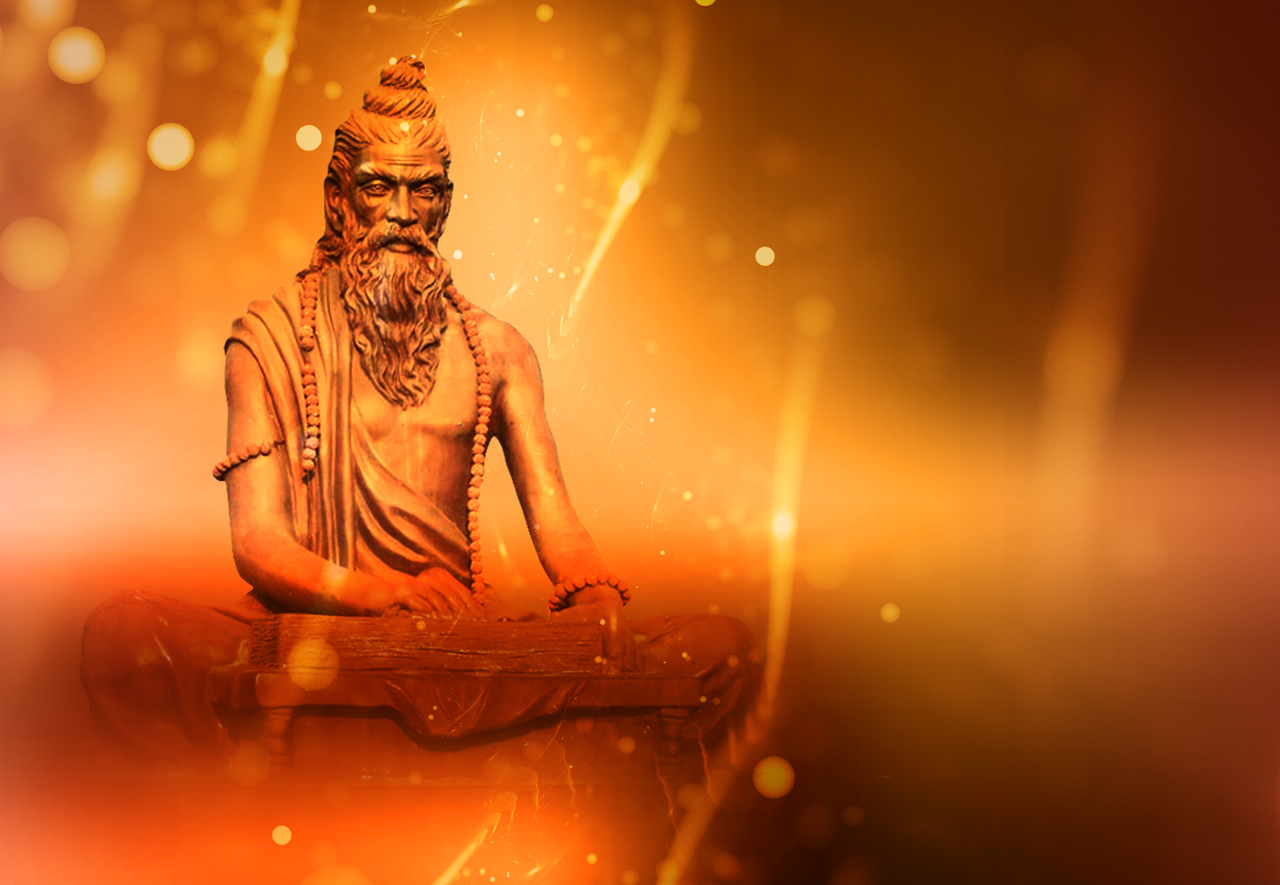
Taking materials about yoga philosophy from ancient traditions, Maharishi Patanjali, sage scientist and propounder of yoga, wrote 196 sutras (aphorisms) on Yoga around 400 CE, popularly known as Patanjali’s Yoga Sutra. In just 196 short sentences, Maharishi Patanjali maps out a complete system of Yoga. Each sutra requires the reader to think deeply for themselves and develop a personal understanding of the practice. What an amazing way to transmit spiritual knowledge!
Eight limbs of yoga
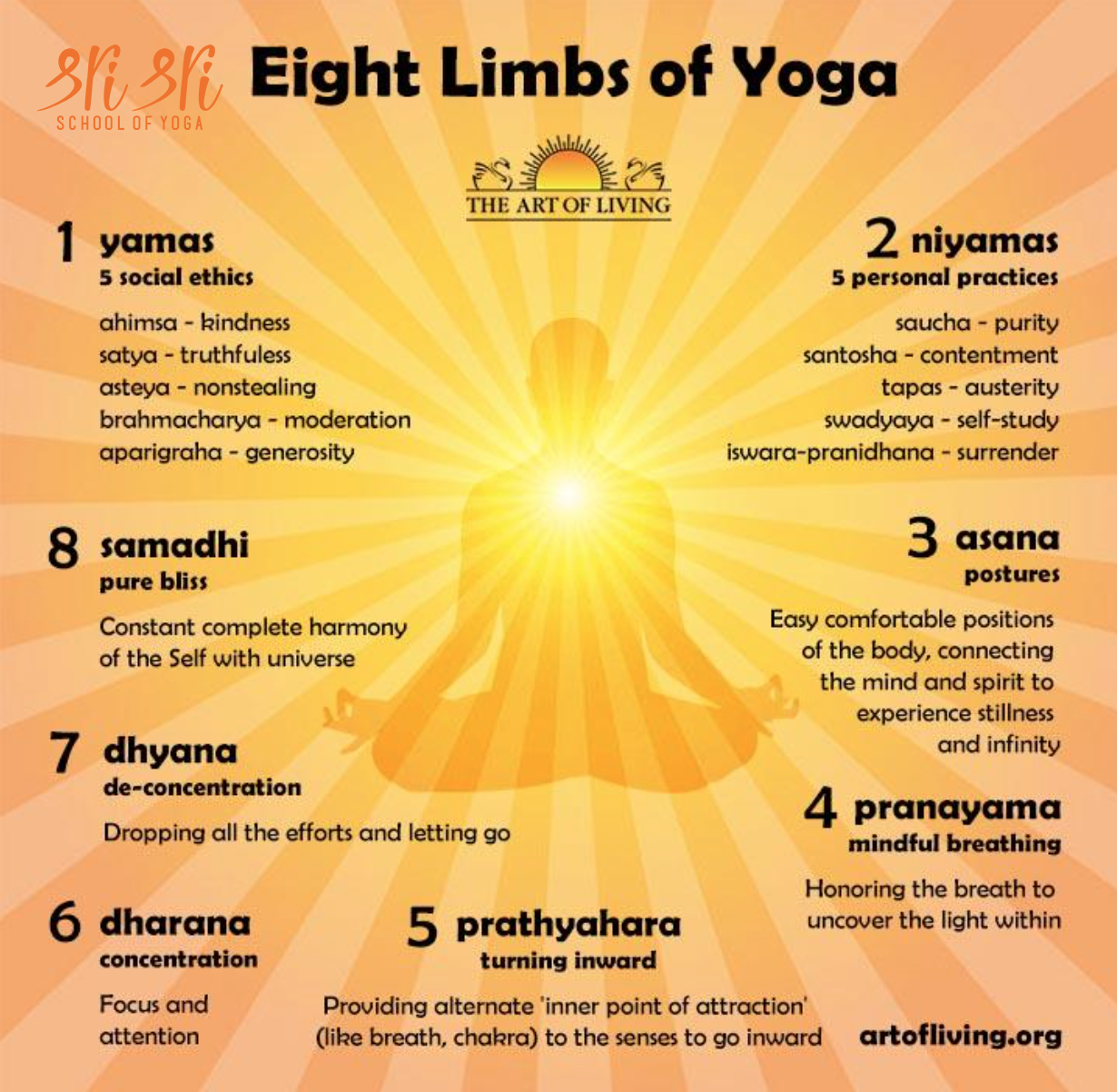
While all the stretching, twisting, balancing is very beneficial, and certainly makes our body healthier and more vibrant, it is just one limb of Yoga. Ancient texts such as the Hatha Yoga Pradipika and The Yoga Sutras focus very little on physical yoga postures (asana practice), and in fact, when Maharishi Patanjali speaks of ‘asana’ he is in no way at all referring to Headstand or Warrior; he’s talking about the position you choose to sit in while meditating – your asana – ‘seat’.
The second chapter of the sutras is generally considered the one most focused on “practice” of the yogic philosophy and lifestyle; there Maharishi Patanjali details the eight limbs of yoga – known as ashtanga yoga. The above graphic can help you understand the eight limbs at a glance.
What are the five Yamas and Niyamas?
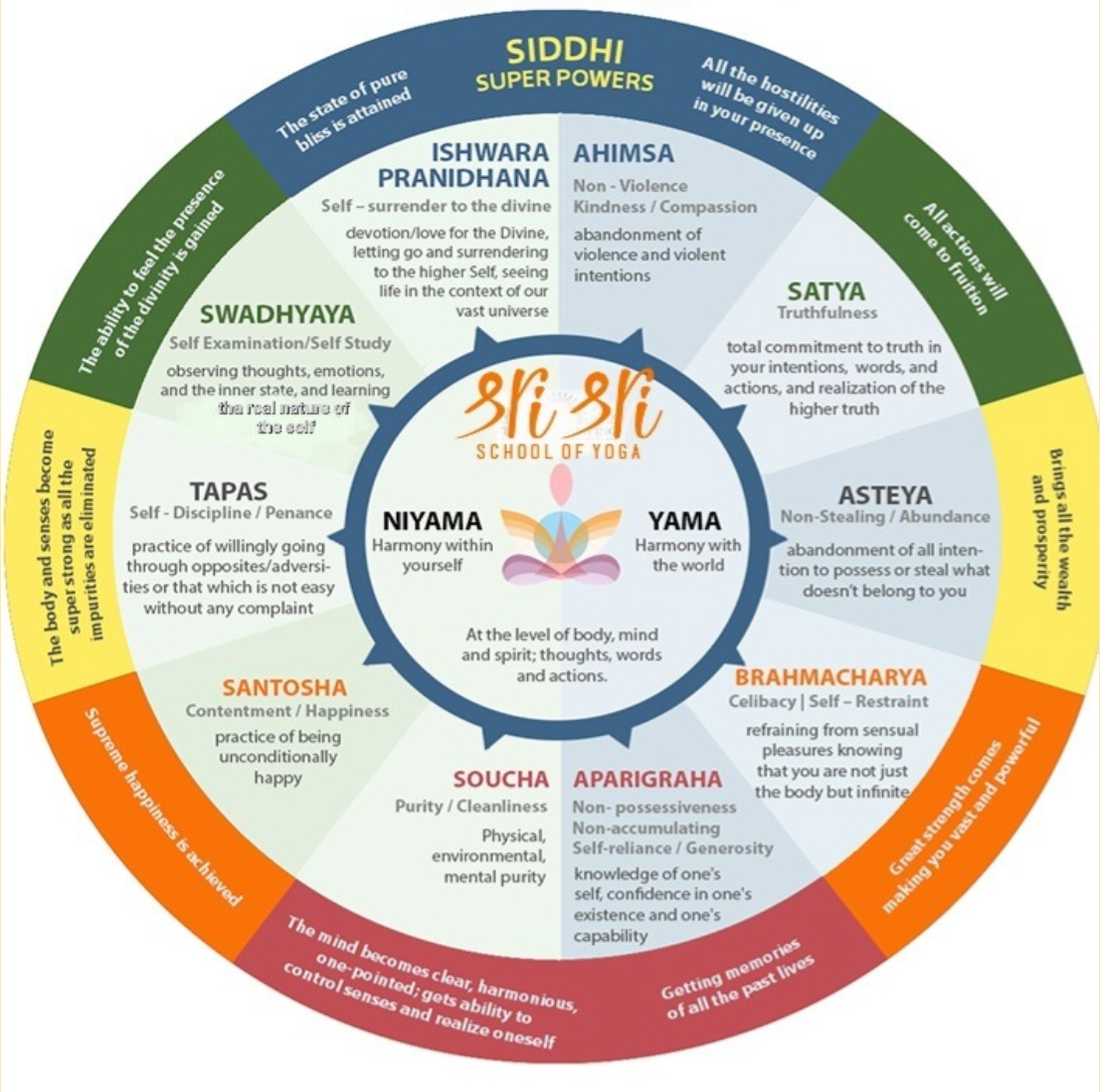
The five Yamas (social ethics) and five Niyamas (personal observances) are two of these eight limbs. Understanding them will help you learn how to practice yoga in your daily life. This can transform you and your yoga practice. These 10 guidelines or ethical principles are like ready-made New Year’s resolutions. The Yamas primarily focus on our actions when in community with others, while the Niyamas focus more generally on our relationship with our physical and psychological selves. The following graphic can help you understand Yamas and Niyamas at a glance along with how they benefit us.
The five Yamas
Yamas are universal morality, attitudes towards society and how you treat others and the world around you. The set of 5 Yamas are:
1) Ahimsa: Non – Violence / Non – Harming / Kindness / Compassion
Abandoning violence and violent intentions. When you are established in Ahimsa, all the hostilities will be given up in your presence.
2) Satya: Non-Deception / Truthfulness
Total commitment to truth in your intentions, words, and actions, and realization of the higher or absolute truth. When you are established in Satya, all your actions will come to fruition.
3) Asteya: Non-Stealing / Honesty /Abundance
Abandoning all intention to possess or steal what doesn’t belong to you. When you are established in Asteya, it brings all the wealth and prosperity.
4) Brahmacharya: Celibacy / Moderation of the Senses / Self – Restraint
Moderation of sensual pleasures knowing that you are not just the body but infinite, moving into the infinity. When you are established in Brahmacharya, great strength comes, making you vast and powerful.
5) Aparigraha: Non-Greed / Self-reliance / Non – possessiveness / Non-accumulating
Letting go of the desire to possess or accumulate with knowledge of one’s Self, confidence in one’s existence and one’s capability. When you are established in Aparigraha, you start getting memories of all the past lives.
The five Niyamas
Niyamas are Personal observances, Attitudes towards ourselves and inner discipline and responsibility. There are 5 Niyamas:
1) Shoucha: Purity / Cleanliness
Maintaining physical, environmental, mental purity and cleanliness. When you are established in Shoucha, your mind becomes clear, harmonious, one-pointed; and you get ability to control senses and realize oneself
2) Santosha: Contentment / Happiness
Practice of being unconditionally happy. When you are established in Santosha, supreme happiness is achieved.
3) Tapas: Self – Discipline / Austerity / Penance
Practice of willingly going through opposites/adversities or that which is not easy without any complaint. When you are established in Tapas, the body and senses become super strong as all the impurities are eliminated.
4) Swadhyaya: Self Examination / Self Study
Studying the real nature of the Self. Observing thoughts, emotions, and the inner state, and learning what is happening inside you and realing all these are fleeting. When you are established in Swadhyaya, the ability to feel the presence of the divinity is gained.
5) Ishvarapranidhana: Surrender to the divine / Spiritual Attunement
Devotion or love for the Divine, letting go and surrendering to the higher Self, seeing life in the context of our vast universe. When you are established in Ishvarapranidhana, the state of pure bliss is attained.
Yamas and Niyamas brings fullness to your practice
Late Dr B K S Iyengar describes both the Yamas and Niyamas as the ‘golden keys to unlock the spiritual gates’, as they transform each action into one that originates from a deeper and more ‘connected’ place within ourselves. From that state of being, we move closer towards wholeness, connectedness and unity, and start to not just ‘do’ yoga, but live and breathe ‘yoga’ in each and every moment.
We all desire to have the benefits of practicing these 10 guidelines or observances. But the benefits are often intangible. In our rush to get on the mat, get moving, and get noticeable and tangible results, we may not spend enough time to understand them, practice them and gauge their impact correctly.
The practice of the Yamas and Niyamas definitely inspires us to remember that yoga is a way of life — not just something we do for 90 minutes three times a week on a rectangular yoga mat. In fact, if they are interwoven in every fabric of our life, every moment becomes sadhana (spiritual practice). They add the necessary juice to our practice. Without them, the rest of the eight limbs may become empty, mechanical and boring.
How to approach the Yamas and Niyamas in daily life?
Step by step?
There is one approach which sees the 8 limbs as steps, and it can lead us to believe that until we follow and master the Yamas and Niyamas, we can not practice other limbs and get benefit out of their practice. This approach may raise many self-doubting questions like –
? How can we calm the mind in meditation, when it is full of anger and discontentment?
? How can we experience the stillness in the posture if we are not ready for tapas (penance)?
? How can we enjoy the relaxation in savasana if we are not prepared to let go and surrender?
? How can we go deeper into our breath when our body and surroundings are not clean enough?
Or as limbs that move together?
Explaining the second approach, Gurudev Sri Sri Ravi Shankar, the world renowned Spiritual Guru, who is my role model and example of a perfect yogi says, “Yoga has eight limbs, like a chair which has got four legs. Each one is connected to the whole. If you pull one leg, the whole chair comes. When the body is developing, the whole body develops together. All the organs of the body develop together. Not that the nose develops first and then the ears come; all the aspects, all the limbs of the body develop simultaneously. That is why Patanjali says that these are all the limbs (not steps) of yoga and they develop simultaneously.”
This understanding, that these eight aspects of yoga are not steps but limbs that grow simultaneously, removes all self doubts and gives us so much space, freedom and enthusiasm to practice yoga as a whole with a full heart.
Yoga anga anushtanat ashuddhi kshaye jnanadi Apthiraviveka khyatehe’’ (Sutra II – 28)
“By the sustained practice of the eight limbs of yoga, the impurities are destroyed and the light of wisdom, discrimination shines forth.”
Explaining this sutra, Gurudev Sri Sri Ravi Shankar says, “Human consciousness is like a seed. A seed has the possibility of a tree, of the leaves, of a branch, of fruits, of flowers, of multiplication; so also the human mind. A seed needs a proper ground, proper conditions, sunlight, water, proper soil for it to sprout and blossom. Similarly human consciousness and human mind. Either the seed can be dormant for years, keeping its possibility within itself, or it starts blossoming, sprouting. The sprouting of the seed of human consciousness is viveka – discrimination. Freedom comes with viveka – discrimination.”
With this I understand that one need not master the 1st or 2nd limb of yoga in order to learn the 3rd to 8th limbs of yoga. All the eight limbs can be practiced simultaneously. And when we practice all 8 limbs together, we have the possibility to fully blossom our human potential. With practice of eight limbs of yoga, the freedom that comes from discrimination dawns in you.
He further says, “To the extent you practice Yamas and Niyamas, you will go deeper into your practice and purpose of yoga. There is no need to doubt or analyze yourself too much. Just the intention to practice Yamas and Niyamas is good enough. Just sow the seeds, keep nurturing them with your practice and relax. The seeds will sprout.”
This is so empowering. With this approach I find that it becomes easy to make the yamas and niyamas an ingrained part of my daily habits; it motivates me that it is easy to cultivate a full and fulfilling Yama/Niyama practice in our modern life, without going to the Himalayas.
Don’t beat yourself up: finding the sweet spot
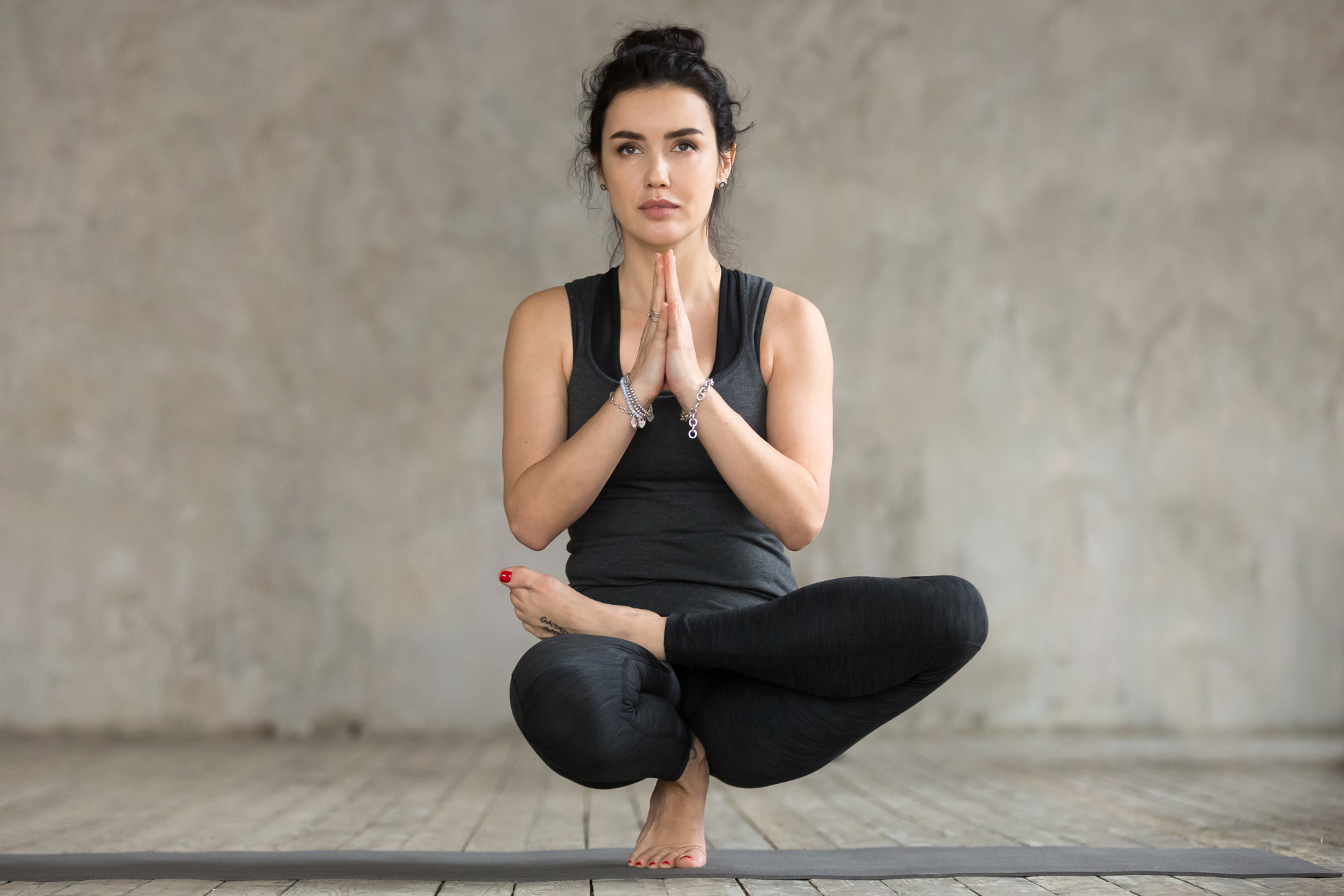
Having understood this approach, the Yamas and Niyamas of the yoga sutras can sometimes feel like sky-high ideals that may take time (a lifetime or even more!) to cultivate and establish. We may be tempted to ignore or overlook them. But paying attention to them is very necessary. In our world of glamor and instant gratification it can seem more desirable and important to learn and perfect triangle pose than to practice kindness and compassion (ahimsa) in every moment. We tend to believe that doing a headstand will be more fulfilling and beneficial than only taking what we need from our planet’s natural resources (aparigraha). It can seem far easier to meditate for 20 minutes a day than to practice contentment (santosha) breath by breath.
The ultimate purpose of practicing the Yamas and Niyamas is to experience real discipline and freedom in our life. But, I have seen people becoming very hard on themselves and the people around them in their attempt to practice yamas and niyamas. This may happen due to misinterpretation of these principles, and forgetting the final purpose of their practice. I also find these 10 principles are so complex and closely interconnected that if I am not fully aware, any linear thinking or misinterpretation of one can lead to the wrong application of the other. It is like walking on a tightrope without losing our balance on either side. For example:
- Aren’t there times when speaking the truth (Satya) might cause hurt or harm to you or somebody? Does that mean we are going away from non-violence (Ahimsa)?
- Aren’t there times when your inability to keep cleanliness (Shaucha) caused you anger and discontentment? Then is this not observing non-violence (Ahimsa) and contentment (Santosha)?
- We all sometimes tend to indulge in or get contentment (Santosha) out of eating not-so-healthy foods that we know cause harm to our body. Does such indulgence take us away from following non-violence (Ahimsa)?
- The majority of us have wardrobes that are more than full, and still we keep buying beautiful outfits one after the other to feel happy and content. Does this mean that we are over accumulating and going far away from keeping the vow of Aparigraha (non-accumulation)?
The Yamas and the Niyamas can apply to large, long-term goals for living, as well as the small decisions we make daily in our interactions with others. How do we live with skill and ethics, peace and self-protection, in a world that may not be necessarily following these guidelines so well? In particular, how do we practice these principles when they seem at cross-purposes?
Practice with reverence is the way
Maharishi Patanjali had been generous to give us such insightful guidance, He says –
“Sa tu dirgha kala nairantarya satkara sevito drudha bhumihi” (Sutra II- 14)
“This becomes firmly grounded or firmly established in you when you attend to it for a long time, without interruption and with honor and respect.”
Being on the path of yoga for more than two decades, though I have made some progress, I still feel that I am scratching the surface of putting them into full practice in my life. But having them as goals in my mind and heart keeps the enthusiasm and fire of Swadhyaya (Study of the Self) alive in me. It is relatively easy for me to observe and apply the obvious or gross aspects of yamas and niyamas. My challenge and next step is how to apply them at very subtle levels, in letter and spirit. Another challenge is how to integrate them with ease, like a flowing river that doesn’t get stuck despite any hurdles, but finds a way to keep flowing no matter what. And finally how do I make them part of me; how do my very being radiate all these beautiful principles. I know this requires great skill, patience and most importantly grace of the Guru.
Integrating Yamas and Niyamas in day to day life
We all want to achieve the coveted position where we have the greatest strength, but also the greatest ease to practice yamas and niyamas. As twenty-first century yogis, we need to approach the Yamas and Niyamas with honor and reverence; with patient and long standing practice with sincere trial and error, with a recognition of the nuances inherent in Maharishi Patanjali’s Sutras, and, most importantly, with a fairly constant self-assessment that considers all 10 guidelines and all other limbs simultaneously. Once understood correctly and mastered, these will slowly but surely become our natural habits that can place us in that perfect state of balance. I am extremely hopeful. Our on the mat practices of asana, pranayama (breathing exercises), and meditation will help us calm the mind and increase self-awareness and thus will help with practice of yamas and niyamas too.
In my future blog posts, I will be sharing my reflections on a general method of incorporating these 10 principles in life, so that they can help integrate them in day-to-day decision-making process and interactions. Stay tuned.
Want to learn more about Yamas and Niyamas?
I highly encourage you to grab your copy of Gurudev’s commentary on Patanjali Yoga Sutra for some excellent discussions of individual Yamas and Niyamas.
Or
Learn more about yamas and niyamas at the 200H yoga teacher training program offered by Sri Sri School of Yoga. To learn more about it, schedule a call with our yoga ambassador right away.


